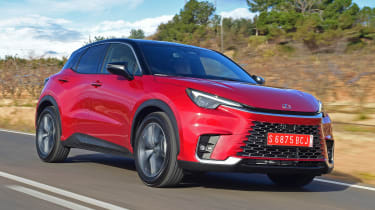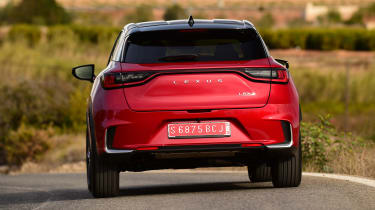New Lexus LBX 2024 review: a small hybrid SUV that fails to stand out
The new Lexus LBX has some plus points, but ultimately there are rivals that offer more for less
Verdict
Lexus has done enough to make the LBX a credible premium small SUV – and the hybrid powertrain means it should find buyers who want electrified efficiency but aren’t ready to jump to a full EV. What they will not be buying, though, is a stellar value proposition; there are still plenty of small electric cars out there for less, and while they may fall short of the LBX’s cabin finish, they more than make up for it with greater practicality and monthly PCP savings.
The new Lexus LBX may be the smallest car the Japanese brand makes, but it’s also one of the most important. This is a Nissan Juke-sized SUV that could open Toyota’s premium division up to a host of new customers, exploit further the transitional benefits of its hybrid powertrain, and give a massive shot in the arm to the company’s sales and market share across Europe. No pressure, then.
The market seems to be moving towards Lexus, too; the car the company considers the most obvious rival for the LBX, the Audi Q2, is due to depart showrooms at some point in 2024. And another key competitor, the MINI Countryman, grows substantially for its forthcoming generation. It’s little wonder that Lexus GB thinks it can use LBX to catapult its annual sales here beyond the 20,000-vehicle mark for the first time.
Yet this is also a car with risks, for the LBX shares a lot with existing Toyotas – more directly than pretty much any Lexus we’ve seen up to now. It uses the same TNGA-B platform as the Yaris Cross, with both cars matched on fundamental layout and body style. They’re both petrol-electric hybrid crossovers, plain and simple – to the point where you wonder how Lexus is really going to add enough value to make its model stand apart, and justify its higher price.
The two cars aren’t completely identical, mind you. For starters, the LBX actually has a slightly longer wheelbase (by 20mm) than the Yaris Cross, and it also has a little more power, with a total of 134bhp, compared with the 129bhp of the range-topping Toyota. There’s a difference in battery technology too, with Lexus claiming that its setup allows better response from the electric part of the car’s powertrain, for punchier, snappier manoeuvres around town.
The TNGA-B platform offers scope for an electrified back axle and sure enough, Lexus has elected to offer that option. So while all LBXs have MacPherson struts at the front, there are a couple of rear-suspension options – a space-efficient torsion beam in front-drive editions like the example we’re driving here, and double wishbones in four-wheel-drive versions. The two extra driven wheels are available only on flagship models, with a premium of around £1,300; Lexus expects them to account for only a few per cent of sales.
Things start encouragingly enough; the LBX looks pretty smart from the outside, with a fresh take on the maker’s spindle grille and an interesting choice of colours – many of them bolder than normal Lexus fare, since this is a car designed to appeal to younger customers.

It feels plush enough when you climb aboard, too; the core architecture looks slicker and better integrated than that of the Yaris Cross, and there are top-quality, stitched materials and dense foam padding in key areas.
The infotainment system is nicely positioned and has a crisp display, plus there are physical controls for heating and ventilation directly beneath it. Plenty of main controls, such as the stubby gear selector and door buttons (instead of regular handles) feel suitably high grade. But it’s not flawless – the mechanism on the central sliding armrest feels a bit cheap, for example – but it’s probably premium enough.
The on-road experience is solid too, though ultimately it lacks any standout attributes. That is to say that Lexus’s claim that the car can run for 50 per cent of the time on electricity around town seems valid enough to us; on the brand’s test route in Valencia, we found it nippy enough to dart in and out of rush-hour traffic, with a little more instant punch than we’re used to feeling in the likes of the Yaris and Yaris Cross.
The low-speed ride is typical TNGA fare; firm but controlled, and rarely uncomfortable. The steering is perhaps a teeny bit heavier than we’d like, and the self centring a little strong, but it’s accurate and makes it easy to place such a compact vehicle in tight city streets.
Things don’t fall apart completely on faster roads, either. Body control is, if anything, better than it needs to be, and while sharp, high-frequency inputs can still hit the dampers sufficiently for jolts to enter the cabin, in general the LBX strikes a good balance between composure and comfort.
There’s not much benefit to pushing on, though; chuck the car at a corner and it just settles dutifully. Any bite, verve or genuine crispness is smothered and softened by a mixture of traction control, stability control, a braking set-up designed to reduce nose pitch, and the distant murmurings of the CVT transmission. It’s fine, safe, secure – just not much fun.
Now, the latest iteration of the hybrid powertrain is much improved over its predecessors, and is impressively smooth at feeding in petrol power when you push the car beyond what the electric bits can do. But once you’re at that point, a patient approach is best, because overly aggressive throttle inputs send the revs rising, accompanied not by a four-cylinder drone but rather a gurgling reminder that this is the first Lexus to feature a three-cylinder motor.
Behave yourself and this shouldn’t be too much of an issue, though; the system generally keeps revs pretty low unless it’s pushed hard, and once you’re up and running, the LBX is both comfortable and refined – only a bit of wind noise from around the side mirrors spoils things at a motorway cruise.
Sadly, if the front cabin experience is a notch above many small SUVs, the rear seats are hardly a triumph. It’s cramped back there, so anyone six feet tall will struggle for foot space, knee room and head room – more so, we’d suggest, than in ‘aspirational mainstream’ rivals like Peugeot’s latest E-2008, or even the Fiat 600 or Jeep Avenger. The Toyota feels narrow, too, so while there is a middle seat, three adults would struggle to fit in the second row.
Much like with so many MINIs, we could see this space being used more frequently as a convenient dumping ground, for shopping and general clutter, than for carrying people. Should owners want or need to use the boot, they’ll find it surprisingly deep – especially on front-drive versions, which have a capacity of 402 litres. A four-wheel-drive car can have as little as 315 litres. But the floor can’t be adjusted for height, so you’ll always have a hefty lip to load heavy items over, and there’s not a single hook to hold a shopping or takeaway bag – only some tiedown anchors in the floor.
Lexus can’t be accused of scrimping on standard equipment with the LBX, however. The range starts with Urban, which brings 17-inch alloy wheels, LED headlights with auto high beam, a seven-inch digital instrument cluster, dual-zone air conditioning, front and rear parking sensors with a rear-view camera, plus Lexus’s very decent Link Connect 9.8-inch infotainment system.
Moving up to Premium brings heated front seats, synthetic-leather upholstery, a wireless smartphone charging pad, rain-sensing wipers and extra safety kit, while Premium Plus adds a larger digital instrument panel, a powered tailgate, a head-up display, extra USB ports, and 18-inch alloys.
Range-topping Takumi comes with semi-aniline leather seats, parking assist, an impressive 13-speaker Mark Levinson audio system, LED fog lights, power adjustment on the driver’s seat and interior ambient lighting. These top two versions can also come with a ‘Design’ suffix that means posher upholstery, machined 18-inch wheels, and a contrast roof colour.
Specs look generous, then – but they ought to, for this is not a cheap car. An LBX Urban will set you back a whisker under £30,000, and by the time you get to the Premium Plus edition that we’re trying here, you’re looking at £34,495 – which is the thick end of nine grand more than a mid-spec Yaris Cross, and £3k up on what Peugeot will charge you for a GT-spec 2008. From our perspective, that looks a chunky uplift for a premium badge.
| Model: | Lexus LBX Premium Plus |
| Price: | £34,495 |
| Engine: | 1.5-litre 3cyl petrol hybrid |
| Power: | 134bhp |
| Transmission: | CVT automatic, front-wheel drive |
| 0-62mph: | 9.2 seconds |
| Top speed: | 106mph |
| Economy: | 60.1-64.2mpg |
| CO2 emissions: | 100-107g/km |
| Dimensions (l/w/h): | 4,190/1,825/1,560mm |
| On sale: | Now |




